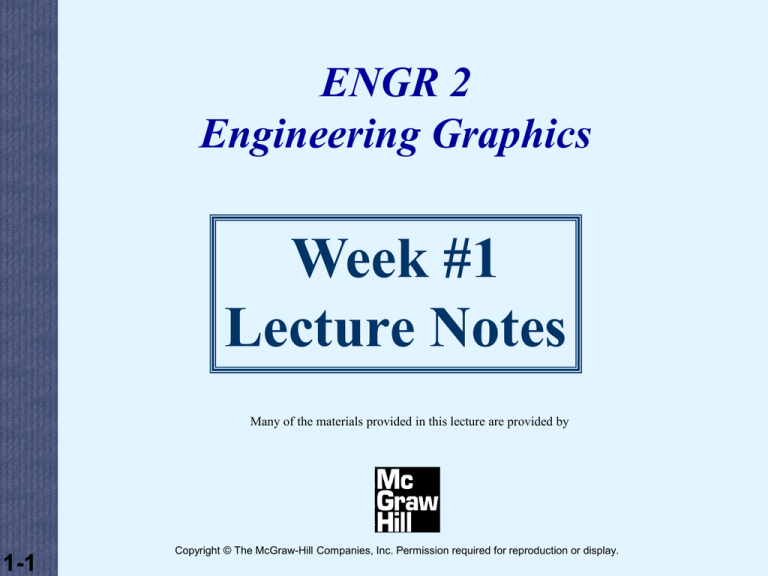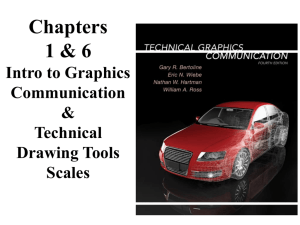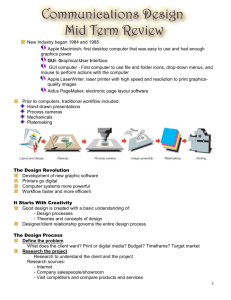Intro 2 - Faculty
advertisement

ENGR 2 Engineering Graphics Week #1 Lecture Notes Many of the materials provided in this lecture are provided by 1-1 Copyright © The McGraw-Hill Companies, Inc. Permission required for reproduction or display. Class Policies Everything is posted on the class web site. http://www.mpcfaculty.net/steven_pearce Review course outcomes. The class is a work in progress. Lecture, lab, and homework information will be posted as it is developed The only enrollment restriction is that the class is limited to students who are currently accepted into a School of Engineering degree program. 1-2 Class Overview The intent of this course is to teach ENGINEERS how to communicate by graphical means. This NOT an AutoCAD class! Yes… we use AutoCAD in the class, but there is no attempt to make you proficient in it’s use. 1-3 Graphics communication using engineering drawings and models is a language, a clear, precise language with definite rules that must be mastered if you are to be successful in engineering design. Once you know the language of graphics communications, it will influence the way you think, the way you approach problems. Why? Because humans tend to think using the languages they know. Thinking in the language of engineering graphics, you will visualize problems more clearly and will use graphic images to find solutions with greater ease. 1-4 In engineering, 92 percent of the design process is graphically based. The other 8 percent is divided between mathematics, and written and verbal communications. Why? Because graphics serves as the primary means of communication for the design process. 1-5 Fig. 1.7 Drafting and documentation, along with design modeling, comprise over 50 percent of the engineer's time and are purely visual and graphical activities. Engineering analysis depends largely on reading engineering graphics, and manufacturing engineering and functional design also require the production and reading of graphics. 1-6 Courtesy of the Grumman Aerospace Corporation Engineering graphics can also communicate solutions to technical problems. Such engineering graphics are produced according to certain standards and conventions so they can be read and accurately interpreted by anyone who has learned those standards and conventions. 1-7 A designer has to think about the many features of an object that cannot be communicated with verbal descriptions. Technical drawings are a nonverbal method of communicating information. 1-8 Engineers are creative people who use technical means to solve problems. They design products, systems, devices, and structures to improve our living conditions. Technologists assist engineers and are concerned with the practical aspects of engineering in planning and production. Both engineers and technologists are finding that sharing technical information through graphical means is becoming more important as more non-technical people become involved in the design/manufacturing process. 1-9 Fig. 1.14 Spoken language and writing are highly refined communications systems that humans use to express emotions, information, and other needs. Mathematics is an abstract, symbol-based communications system built on formal human logic. Graphics is a visual communications language incorporating text, images, and numeric information. 1- 1-11 Engineering graphics is a real and complete language used in the design process for: 1. Communicating 2. Solving problems 3. Quickly and accurately visualizing objects. 4. Conducting analyses. Fig. 1.24 1- Fig. 1.20 1- 1-14 • Visual science is the study of the visual and technical applications of graphics. Visualization is the process of mentally understanding visual information. Geometry is a branch of mathematics that deals with the properties, relationships, and measurements of points, lines, angles, planes, and solids. Visualization ability and a knowledge of geometry combine to create both artistic and technical drawings. • Artistic drawings are used to express aesthetic, philosophical, and abstract ideas, while technical graphics or technical drawing is a specialized type of graphics used to communicate technical information. • Plane geometry - the geometry of planar figures, such as circles and triangles, and their relationships. • Solid geometry - the geometry of three-dimensional objects, such as cylinders, cubes and spheres, and their relationships. • Analytic geometry - the analysis of geometric structures and properties, principally using algebraic operations and position coordinates. • Descriptive geometry - the science of analyzing and solving space distances and relationships, using graphics. • Conventions are commonly accepted practices, rules, or methods used in technical drawing. • Standards are sets of rules that govern how technical drawings are represented. Standards allow for the clear communication of technical ideas. In the United States, the American National Standards Institute (ANSI) is the governing body that sets the standards used for engineering and technical drawings. 1-15 A drawing is a graphical representation of objects and structures and is done using freehand, mechanical, or computer methods. Drawings may be abstract, such as the multiview drawings, or more concrete, such as very sophisticated computer models. Fig. 1.25 Technical drawing is used to represent complex technical ideas with sufficient precision for the product to be mass-produced and the parts to be easily interchanged. 1-16 Reprinted from ASMEY 14.5M-1994, Dimensioning and Tolerancing, by permission of The American Society of Mechanical Engineers 1-17 Mechanical engineering comprises a wide range of activities that include the research, design, development, manufacture, management, and control of engineering systems and their components. Mechanical engineers use a wide variety of mechanical drawings and computer models for design and analysis. Electrical engineering includes the research, design, development, marketing, field testing, and operation and maintenance of electrical and electronic systems and their components. Electrical engineers use schematic drawings and electromechanical drawings of electrical systems for communications. Civil engineering involves the planning, design, construction, operation, and maintenance of transportation, environmental, and construction systems. Civil engineers use working drawings of construction systems, map drawings, and other detail drawings for communications. 1-18 As a student of engineering graphics, you will study and learn to apply the tools used to create engineering drawings and models. Even more important, you will also learn the underlying principles and concepts of engineering graphics, such as descriptive geometry. You will also learn the standards and conventions that will enable you to create drawings and models that can be read and accurately interpreted by engineers or technologists anywhere. The ability to draw is a powerful skill. It gives a person’s thoughts visible form. Engineering drawings can communicate complex ideas both efficiently and effectively, and it takes special training to be able to produce these complex images. If drawings are “windows to our imaginations,” then engineering drawings are specialized windows that give expression to the most complex, technical visions our minds can imagine. Engineering drawing does more than communicate. Like any language, it can actually influence how we think. Knowing how to draw allows you to think of and deal with many problems that others may not. A knowledge of technical graphics helps you more easily envision technical problems, as well as their solutions. In short, engineering graphics is a necessity for every engineer and technologist 1-19 Technical graphics is an integral part of the engineering design process through which engineers and drafter/designers generate new ideas and solve problems. Traditional engineering design consists of closely related steps that flow both sequentially and back and forth. Many industries in the United States are changing their design methodology from a linear/sequential activity to a team approach in which all parts of the company are working on a project simultaneously. 1-20 Design is the process of conceiving or inventing ideas mentally and communicating these ideas to others in a form that is easily understood. Most often the communications tool is graphics. Design is used for two primary purposes: personal expression, and product or process development. Design for personal expression, usually associated with art, is divided into concrete (realistic) and abstract design and is often a source of beauty and interest. When a design serves some useful purpose, such as the shape of a new automobile wheel, it is classified as a design for product or process development. Fig. 2.1 2- Fig. 2.2 2- 1-23 Engineering Design Components Aesthetic design is concerned with the look and feel of a product. Functional design is concerned with the function of a product or process. Function means that a product possesses a form related directly to the purpose of that product. 1-24 Aesthetic design Form is the overall physical appearance of a product and consists of many elements, the arrangement of which is critical to the aesthetics and function of the product. These elements are: • Unity is the use of similar elements throughout the design or product line. The engineer accomplishes unity by thinking of the product as a whole instead of as individual parts or components. • Style is the addition of decoration to a product and is closely linked to marketing. • Line is another characteristic of a product. • Space is the relationship of a product to its background, as well as to its negative elements (holes, slots, voids). • Mass is the design element that provides a sense of weight or heaviness. • Proportion is the relationship of the smaller elements to the whole design. • Balance is the design element that gives the product equilibrium. • Contrast is the feature used to emphasize or de-emphasize certain elements in a design. • Color is the element used to evoke emotions, give sensations of weight, and enhance a design form. Fig. 2.4 2- © Michael Rosenfeld: Stone 1-26 Engineering design is a problem-solving process that uses knowledge, resources, and existing products to create new goods and processes. Engineering design has both aesthetic and functional elements and can be broken into two broad categories: product design and system design. Product Design is the process used to create new products, such as a new automobile model, a new appliance, and a new type of wheelchair. Product design is a complex activity that includes market, production, sales, service, function, and profit analyses used to produce a product that meets the wants and needs of the consumer, is economically produced, is safe for the consumer and the environment, and is profitable to the company. System design is the process used to create a new system or process. A system is an orderly arrangement of parts that are combined to serve one general function. Examples of the system designs are: the arrangement of the assembly process in a factory; the heating, ventilation, and air-conditioning (HVAC) system in a structure; and the electrical system in the automobile. 1-27 Engineering design is one of the processes normally associated with the entire business or enterprise, from receipt of the order or product idea, to maintenance of the product, and all stages in between. An engineering design involves both a process and a product. A process is a series of continuous actions ending in a particular result. A product is anything produced as a result of some process. Graphics is an extremely important part of the engineering design process, which uses graphics as a tool to visualize possible solutions and to document the design for communications purposes. Traditional engineering design is a linear approach divided into a number of steps. For example, a six-step process might be divided into: problem identification, preliminary ideas, refinement, analysis, documentation, and implementation. The design process moves through each step in a sequential manner; however, if problems are encountered, the process may return to a previous step. This repetitive action is called iteration or looping. 1-28 Traditional engineering design is a linear approach divided into a number of steps. For example, a six-step process might be divided into: problem identification, preliminary ideas, refinement, analysis, documentation, and implementation. The design process moves through each step in a sequential manner; however, if problems are encountered, the process may return to a previous step. This repetitive action is called iteration or looping. 1-29 Concurrent engineering is a nonlinear team approach to design that brings together the input, processes, and output elements necessary to produce a product. The concurrent engineering model shows how every area in an enterprise is related, and the CAD database is the common thread of information between each area. Fig. 2.7 2- 1-31 The engineering design process consists of three overlapping areas: ideation, refinement, and implementation which all share the same CAD database. Current engineering design practices makes use of a number of new practices, including Intranets and Extranets, e-Business, and the Digital Enterprise. Fig. 2.8 2-32




